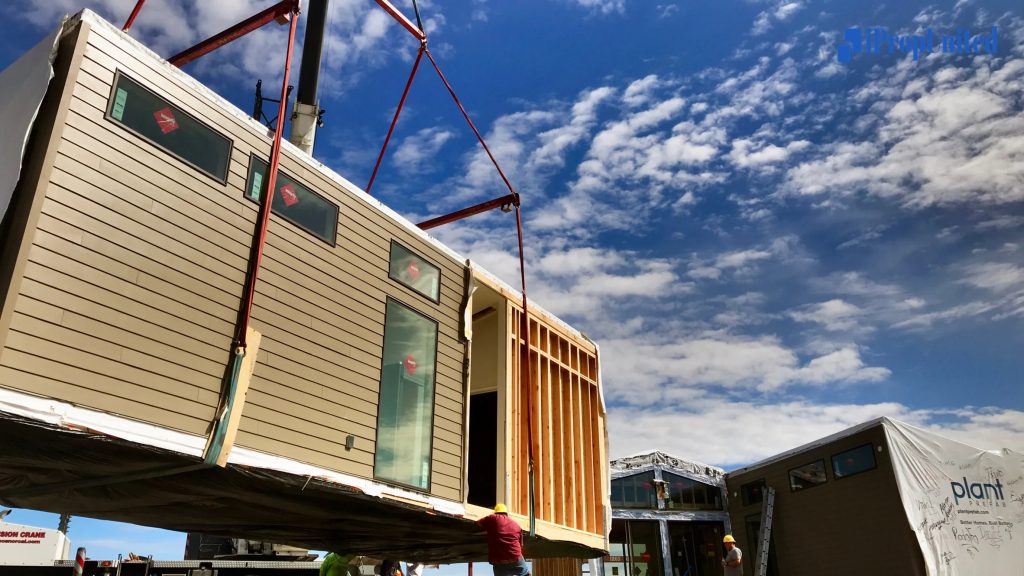Prefabricated buildings, which are frequently constructed off-site, have become extremely popular in recent years. There are some drawbacks to prefabricated building formats, despite the advancement of technology, decreased pollution, and lower cost of construction.
Prefabricated construction, which began in Europe after World War II, has recently become a common trend in many parts of the world and is rapidly catching up in India. The construction of a prefabricated or prefab building involves assembling of various components produced in a factory at the development site. For example, steel frames for buildings, panels made of wood, cement, gypsum, and other materials for walls and floors, ceilings, as well as manufactured doors, windows, and ventilators, are some of the raw materials used most frequently in prefabricated buildings.

Modular homes come in segmented parts and save time, money, and energy compared to traditional homes, where a team of workers must spend months building the structure. But before making a choice, experts advise weighing the advantages and disadvantages.
Advantages of prefabricated buildings
Saves construction time
The ability to build a project more quickly than with traditional methods is one of prefab’s biggest advantages. Assembling and connecting the parts are the only tasks left to be completed on the construction site because all the parts have already been partially built.
“The entire process takes 6-8 weeks based on the internal and external specifications,” says Sumit Agrawal, Architect and Interior Designer. For example, if your home plans are straightforward without any intricate engineering or custom details, it might take 4-6 weeks, whereas the assembling process only takes 2-3 weeks.
Cost-effective
Prefab homes are comparatively more affordable as traditional construction costs rise. It uses inexpensive building supplies like plasterboard, floor tiles, and terrace block. Many developers have begun using prefab materials in their buildings because of the low cost. The outer structure is constructed using traditional methods. But internal division and expansion are accomplished with prefab.
Minimizes ecological pressure
The largest contributor to environmental pollution worldwide is the construction industry. The high rate of construction activity, combined with a poor choice of raw materials, significantly contributes to the environmental threat. The primary building material, burnt brick, is the primary source of air pollution and greenhouse gas (GHG) emissions.
The production of 170 billion bricks annually uses about 24 million tonnes of coal and emits 61.3 million tonnes of CO2, according to the TERI Report, Green Growth and Building Sector in India, 2015. Cement and steel are also two important materials that increase GHG emissions.
In contrast, modular homes made without cement and bricks are more environmentally friendly. Aside from that, there is noise pollution because the building components are created off-site.
Disadvantages of prefabricated buildings
Lengthier planning process
The planning process is typically lengthy, even though the construction and assembling of the prefab property may not take much time. It takes a lot of time and effort to find the land, choose the contractor, and prepare the site.
Quality problems
Prefab structures are infamous for not offering the same level of quality as traditional structures. These methods only offer a small number of customization and service options. According to Shivakshi Gogia, CEO of Ascent Group, “Building designs have restrictions on dramatic aesthetic changes, and costs increase greatly when building sites are located more than 500 miles from the factory.
Threat of damage
Prefab structures are transported from the factory site to the construction site, and there is always a risk of damage during transit, according to architect and interior designer Sumit Agrawal. In addition, the cost may increase depending on how far the modules must travel.
Inefficient assembling
When installing the modules, pay attention to detail. Any assembling error may result in leaks, void spaces, or joint problems. Therefore, precise assembly is essential. To prevent issues in the future, proper consideration should be given to the measurements and placing of large prefabricated buildings.
For purchasers with a clear plan of what they want within a confined timeline and a specific price range, prefab homes are ideal. Anyone considering a self-build should be sure they are fully aware of all their options and when each option is best. Prefab homes are not right for everyone or every site.
Although offering various advantages over traditional residences, you are still responsible for the construction of such homes. Conduct thorough research and consult with the manufacturer to make sure that quality requirements are being met and there are no inconsistencies.
Follow and Connect with us: Twitter, Facebook, Linkedin, Instagram







